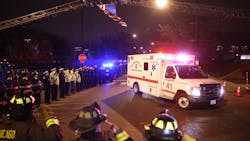Lessons learned from the Mercy Hospital shooting
Last month, a young emergency room doctor, Tamara O’Neal, was shot to death in the parking lot of Chicago’s Mercy Hospital. She was killed by her ex-finance, Juan Lopez, who confronted her because he wanted to get an engagement ring back.
According to Chicago Police Supt. Eddie Johnson, a friend tried to intervene in the argument, at which point Lopez lifted his shirt and displayed a handgun. The friend fled into the hospital, and witnesses said they saw Lopez stand over Dr. O'Neal and shoot her at least six times.
Lopez subsequently ran into the hospital through the ER entrance and killed a young pharmacy resident as she walked out of an elevator. He then saw two police officers approaching and shot at them, killing Officer Samuel Jiminez. The second officer was shot, but the bullet lodged in his holster, saving his life.
Lopez then turned the gun on himself and shot himself in the head. An autopsy later showed, however, that Lopez was fatally wounded by a police bullet that entered his abdomen.
Lopez had a history of violence. After the shooting, the Chicago Fire Department's Office of Internal Affairs released a 14-page document which detailed the problems with Lopez that began when he was in training to be a firefighter in 2014. According to court records, Lopez made threats, harassed his estranged wife and slept with a gun under his pillow. When his wife prepared to leave him in 2014, complaining that he once pointed a gun at a real-estate agent, she said he threatened to show up at her workplace and “cause a scene.”
The Chicago Tribune reported that Lopez had obtained his gun legally and had, in fact, purchased four guns over the last five years and had a current concealed carry permit.
Mercy’s Security Controls Questioned
One of the most concerning elements of this tragic incident were questions that came up about the security controls in place at the hospital at the time of the shooting spree.
Active shooters and angry patients at hospitals have been responsible for a dramatic increase in violence in healthcare. Although this incident unfolded in a hospital, shootings have taken place in nursing homes, rehabilitation centers, hospices, and psychiatric facilities.
The Department of Labor Statistics reported in 2017 that hospital workers face more dangerous conditions than high rise construction workers and other occupations considered very dangerous. Based on what I’ve read and my years of experience in healthcare security, Mercy Hospital in this case was not sufficiently locked down after the shooting. While Michael Davenport, the hospital’s Chief Medical Officer, said their emergency plans call for barricading doors, the fact that the gunman was able to run into the ER after the shooting in the parking lot means that such a barricade was not in place when it needed to be.
Many hospital emergency rooms in high crime, inner city areas include a uniformed security officer, or off-duty law enforcement, but neither of these were present at the Mercy Hospital shooting. If someone had been present, the shooter could have been isolated, or locked out of the hospital.
In a parking lot shooting, camera monitoring systems can also instantly allow emergency staff to see the incident as soon as a shot is fired. But this active monitoring did not seem to be in place at Mercy Hospital.
Best Practices and Technology Recommendations
In reviewing the incident and its progression, it is obvious that there are several different elements that could have saved lives in this incident. While there was no way to prevent the initial shooting of Dr. O’Neal, after that, there are several systems that should have been activated.
- Access control to the emergency room. Strong access control procedures, or even using an automatic lockdown to close the hospital entrances, would have been a critical control to put in place to protect the hospital staff from the shooter.
- Individual panic alarms that could have been activated should have been in use at all entrances, to alert staff and patients of imminent danger, and to alert other areas of the hospital.
- Improved communication systems, specifically to address active shooter incidents could have kept the staff informed about the location of the shooter. Reports came in during the incident that there was general confusion, with many conflicting reports circulating about the current situation.
- Based on the past history of Lopez, if the domestic incident had been put into a Case Management System, a restraining order might have been issued, forbidding Lopez from entering hospital property, and alerting police and any onsite security that he was a potential danger.
After the incident, Davenport said the hospital had conducted an active shooter drill the previous month. Unfortunately, holding active shooter training sessions and drills is not enough to prevent an incident. Instead, the training and drills focus on what to do after an incident occurs, not what to do to prevent an incident from occurring in the first place.
Controls now available to prevent active shooters are becoming much more sophisticated, including automatic lockdown systems as well as technology that recognizes the sound of a gunshot and automatically alerts local law enforcement.
How does a hospital or healthcare organization decide which controls it needs to incorporate to make sure the staff and patients in the hospital or healthcare facility are protected?
Starting with a specialized Active Shooter Risk Assessment is an approach that allows the organization to understand the threat level of their facilities, and what controls will provide the best protection at the most reasonable cost.
By using return on investment as a metric, the hospital can have more controls without wasting money on a single control that might consume the entire security/public safety budget.
Details from the FBI Crime Index showed that Mercy Hospital was in a dangerous location with a very high crime rate, which was higher than 92 percent of cities in the U.S., with over 30,000 violent crimes a year. Other threats to hospitals and healthcare facilities include assault, rape, theft, armed robbery, bullying, and a variety of natural disasters.
The Centers for Medicare and Medicaid (CMS) Final Rule on Emergency Preparedness now requires hospitals, critical access hospitals, and fourteen other kinds of healthcare facilities to do annual all-hazards security risk assessments, for each separate facility. It also requires mandatory training for all healthcare staff members and two drills a year.
The increased requirements reflect the issues, like the Mercy Hospital shooting, that have been increasing in hospitals over the last ten years. As the threats increase, it becomes more and more important to have controls in place that will either prevent an incident from occurring or reduce the severity of a violent incident if it does occur.
When conducting an Active Shooter Threat Assessment, we use a total of sixty-two controls that will contribute to protecting the hospital and healthcare facilities. The controls that are identified can then be analyzed in relation to the list of potential threats to calculate the threat reduction potential for each control.
By identifying each control by the cost to implement, you can calculate the savings that the control contributes to the Threat Reduction and the Cost Benefit analysis for each potential control. The recommended controls can then be put into a Corrective Action Plan that will improve the safety and security of the hospital’s staff, patients, and visitors over time.
The tragic shooting at Chicago’s Mercy Hospital was another example of the high rate of violence that is currently experienced by healthcare providers and hospitals. While it is almost impossible to prevent angry people from attacking their domestic partners, or taking their anger out on their co-workers, it is possible to reduce active shooter incidents by ensuring that there is a set of controls in place that can reduce the number of incidents, reduce and prevent the harm that comes from these incidents, and limit the damage from an active shooter.
About the Author:
Caroline Ramsey-Hamilton is an Active Shooter Risk Assessment Expert who has worked with hundreds of hospitals, psychiatric hospitals, surgery centers, federal agencies, college and universities and organizations including the Palm Beach County Association of Police Chiefs, State Healthcare Coalitions, and federal, state, and local governments. She has created risk models for pediatric medication errors, analysis of nuclear facilities for the Nuclear Regulatory Commission, and the International Association of Healthcare Safety and Security. Ramsey-Hamilton is certified in Homeland Security, and Accredited by the Anti-Terrorism Accreditation Board. She is also a Risk Consultant for Pinkerton, Inc.
About the Author

Caroline Ramsey-Hamilton
President, Risk and Security, LLC
Caroline Ramsey-Hamilton is a leading threat and risk assessment expert in both physical and IT security. She has developed many specialized risk and threat assessment programs for hospitals, healthcare organizations and large public and private organizations including the Department of Defense, the Department of Homeland Security, the Department of Justice, and companies like Northrop Grumman, AT&T, Parrish Medical, and Magellan Health Services, Inc. Ramsey-Hamilton also serves on the board of the South Florida Chapter of the International Association of Healthcare Security and Safety.
